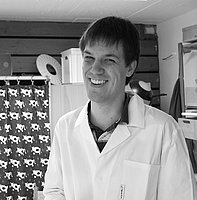A strange sight to behold would have met anyone who entered room HNC 20 at RUB on the 24th of July around 5 o’clock: Roughly 90 people sitting with 3D glasses in the dark, their eyes fixed on the presentation in the front of the lecture hall. A 3D lecture in an university?!? The audience, usually conducting chemical experiments, had become participants in an interesting social experiment themselves! The occasion for this unusual form of presenting research results was a talk by Prof. Uwe J. Meierhenrich, distinguished researcher in astrochemistry from the Université Nice Sophia Antipolis in France. Under the headline “Rosetta Mission: Organic Molecules Detected in Cometary Ices” he presented his search for the origin of biologically important compounds in the universe in a two-part lecture.
Since all good science starts in the lab, Prof. Meierhenrich first introduced his earthly experiments regarding one of the most intriguing questions about life on Earth: Have comets delivered the essential compounds for the evolution of life on our planet, such as amino acids or sugars? In the laboratory, Meierhenrich could simulate the syntheses going on in cometary ices under the bombardment of UV irradiation that the comets are exposed to in deep space. He and his collaborators irradiated model mixtures of ammonia, methanol, carbon monoxide and CO2, molecules that are commonly detected in interstellar ices. By tinkering with these simple ingredients they were able to synthesize exactly the sought-for complex organic molecules.
Measurement time – in space!
Then Meierhenrich brought us to his extraterrestrial experiments as part of the European Space Agency’s Rosetta Mission. In cooperation with the Max-Planck-Institute for Solar System Research in Göttingen his team developed the Cometary Sampling and Composition (COSAC) Experiment that was part of the Philae Lander’s experimental arsenal. Upon landing on the comet 67P/Churyumov–Gerasimenko (nickname: Chury) on the 12th of November 2014, its goal was to analyse the chemical composition of the comet’s dust raised during the lander’s touchdown. As we know, the touchdown was not quite as soft as the research team had anticipated – in fact, the probe bounced off the comet’s surface twice and tumbled through space before finally finding its ultimate landing zone among rocks on the comet’s smaller lobe.
Despite these problems that might have easily torpedoed the whole mission, COSAC was able to take (or “sniff” as the chemists nicknamed the process) and analyse a sample from the comet’s dust: Indeed, it showed that Chury is carrying at least 16 organic chemicals, having been formed from water, ammonia, carbon monoxide and methane on the comet’s billion-year journey through the universe. Four of these molecules, amongst them acetone that is probably best known from nail polisher to most people, could be detected on a comet for the first time. Many of these molecular passengers on Chury are essential for potentially sparking off life on any planet that the comet might crash into. This hypothesis of comets as interstellar shuttles for prebiotic material has become known as panspermia and is still being investigated by many experiments every year.
Comets are all but dead rocks travelling through the universe
Of course, the French astrochemist did not just convey the hard science of this mission during his talk, but also gave some personal insights into Rosetta’s preparation: In an amusing side note, for instance, he told the anecdote of three ESA engineers having folded in the Philae lander the wrong way. This went undetected until after the mission launch but fortunately did not cause any serious problems during the approach. He also presented original 3D photos and films taken by the Rosetta space probe circling Chury which was where the 3D glasses were put to good use. This way, we experienced Philae’s landing on the comet nearly exactly like the researchers heading this project or statesmen like François Hollande in the mission’s headquarters all around Europe on that memorable day almost three years ago.
Though people rarely think of a cometary ice, frozen in the vacuum of space at less than -270 degrees, as a solution, it is still intriguing to think of the effect of the surrounding water: Is it merely a spectator when complex prebiotic molecules are formed? Or does it participate, perhaps in strange and startling ways we still have to unveil? Meierherich’s talk was of great inspiration to those of us investigating solvation at extreme conditions and it showed that fundamental research might lead you to some unusual and indeed cool places.
Literature:
“Ribose and related sugars from ultraviolet irradiation of interstellar ice analogs”, Meinert, Meierhenrich et al. Science 352 (2016) 208-212.
“Amino acids from ultraviolet irradiation of interstellar ice analogues”, Muñoz Caro, Meierhenrich et al. Nature 416 (2002), 403-406.
“Organic compounds on comet 67P/Churyumov-Gerasimenko revealed by COSAC mass spectrometry”, F. Goesmann, U.J. Meierhenrich et al., Science 349 (2015).
Special issue of Science (2015): Catching a comet
—————————————————————————————————————————————
About the author




